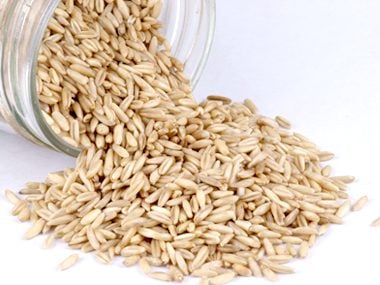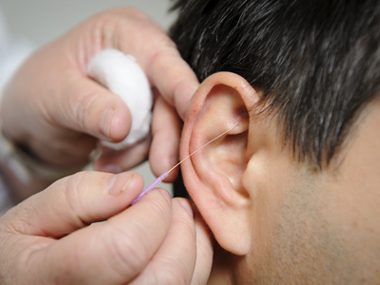Not sure how to quit smoking cigarettes? Try one of these 20+ ways to stop smoking and start your path towards a healthier, smoke-free life.
Make an honest list of all the things you like about smoking.
 ISTOCK/THINKSTOCK
ISTOCK/THINKSTOCKDraw a line down the center of a piece of paper and write them on one side; on the other side make a list of all the things you dislike, such as how it can interfere with your health, work, family, etc., suggests Daniel Z. Lieberman, M.D., director of the Clinical Psychiatric Research Center at George Washington University Medical Center in Washington, D.C. Think about the list over time, and make changes. If you are brave enough, get feedback from family and friends about things they don’t like about your use of cigarettes. When the negative side outweighs the positive side, you are ready to quit.
Then make another list of why quitting won’t be easy.
 ISTOCK/THINKSTOCK
ISTOCK/THINKSTOCK
Be thorough, even if the list gets long and discouraging. Here’s the important part: Next to each entry, list one or more options for overcoming that challenge. For instance, one item might be: “Nicotine is an addictive drug.” Your option might be: “Try a nicotine replacement alternative.” Another reason might be: “Smoking helps me deal with stress.” Your option might be: “Take five-minute walks instead.” The more you anticipate the challenges to quitting, and their solutions, the better your chance of success.
Set a quit date.
 ISTOCK/THINKSTOCK
ISTOCK/THINKSTOCK
Write a “quit date contract” that includes your signature and that of a supportive witness.
Write all your reasons for quitting on an index card.
 PHOTICK/THINKSTOCKHere are some to get you started: “My daughter, my granddaughter, my husband, my wife…”
You get the idea. Keep it near you at all times.
PHOTICK/THINKSTOCKHere are some to get you started: “My daughter, my granddaughter, my husband, my wife…”
You get the idea. Keep it near you at all times.As you’re getting ready to quit, stop buying cartons of cigarettes.
 ISTOCK/THINKSTOCKInstead, only buy a pack at a time, and only carry two or three with you at a time (try putting them in an Altoids tin). Eventually, you’ll find that when you want a smoke, you won’t have any immediately available. That will slowly wean you down to fewer cigarettes.
ISTOCK/THINKSTOCKInstead, only buy a pack at a time, and only carry two or three with you at a time (try putting them in an Altoids tin). Eventually, you’ll find that when you want a smoke, you won’t have any immediately available. That will slowly wean you down to fewer cigarettes.Keep a list of when you smoke for a week before quitting.
 ISTOCK/THINKSTOCKAlso note what you’re doing at the time and how bad the craving is to see if specific times of the day or activities increase your cravings, suggests Gaylene Mooney, chair of the American Association for Respiratory Care’s Subcommittee on Smoking and Tobacco-Related Issues.
ISTOCK/THINKSTOCKAlso note what you’re doing at the time and how bad the craving is to see if specific times of the day or activities increase your cravings, suggests Gaylene Mooney, chair of the American Association for Respiratory Care’s Subcommittee on Smoking and Tobacco-Related Issues.Prepare a list of things to do when a craving hits.
 ISTOCK/THINKSTOCKSuggestions include: take a walk, drink a glass of water, kiss your partner or child, throw the ball for the dog, play a game, wash the car, clean out a cupboard or closet, have sex, chew a piece of gum, wash your face, brush your teeth, take a nap, get a cup of coffee or tea, practice your deep breathing, light a candle. Make copies of the list and keep one with you at all times so when the craving hits, you can whip out the list and quickly do something from it.
ISTOCK/THINKSTOCKSuggestions include: take a walk, drink a glass of water, kiss your partner or child, throw the ball for the dog, play a game, wash the car, clean out a cupboard or closet, have sex, chew a piece of gum, wash your face, brush your teeth, take a nap, get a cup of coffee or tea, practice your deep breathing, light a candle. Make copies of the list and keep one with you at all times so when the craving hits, you can whip out the list and quickly do something from it.Quit when you’re in a good mood.
 DIGITAL VISION/THINKSTOCKStudies find that you’re less likely to be a successful quitter if you quit when you’re depressed or under a great deal of stress.
DIGITAL VISION/THINKSTOCKStudies find that you’re less likely to be a successful quitter if you quit when you’re depressed or under a great deal of stress.When your quit date arrives, throw out anything that reminds you of smoking.
 ISTOCK/THINKSTOCKThat includes all smoking paraphernalia — leftover cigarettes, matches, lighters, ashtrays, cigarette holders, even the lighter in your car.
ISTOCK/THINKSTOCKThat includes all smoking paraphernalia — leftover cigarettes, matches, lighters, ashtrays, cigarette holders, even the lighter in your car.Put all the money you’re saving on cigarettes in a large glass jar.
 ISTOCK/THINKSTOCKYou want to physically see how much you’ve been spending. Earmark that money for something you’ve always dreamed of doing, but never thought you could afford, be it a cruise to Alaska or a first-class ticket to visit an old college friend.
ISTOCK/THINKSTOCKYou want to physically see how much you’ve been spending. Earmark that money for something you’ve always dreamed of doing, but never thought you could afford, be it a cruise to Alaska or a first-class ticket to visit an old college friend.Switch to decaf until you’ve been cigarette-free for two months.
 ISTOCK/THINKSTOCKToo much caffeine while quitting can cause the jitters.
ISTOCK/THINKSTOCKToo much caffeine while quitting can cause the jitters.Think of difficult things you have done in the past.
 ISTOCK/THINKSTOCKAsk people who know you well to remind you of challenges you have successfully overcome, says Dr. Lieberman. This will give you the necessary self-confidence to stick with your pledge not to smoke.
ISTOCK/THINKSTOCKAsk people who know you well to remind you of challenges you have successfully overcome, says Dr. Lieberman. This will give you the necessary self-confidence to stick with your pledge not to smoke.Find a healthy snack food you can carry with you.
 ISTOCK/THINKSTOCKIn place of smoking cigarettes, try sunflower seeds, sugar-free lollipops, or gum, or carrot or celery sticks if you’re concerned about weight gain. You can also switch your cigarette habit for a nut habit, and eat four nuts in their shell for every cigarette you want to smoke. This way, you’re using your hands and your mouth, getting the same physical and oral sensations you get from smoking.
ISTOCK/THINKSTOCKIn place of smoking cigarettes, try sunflower seeds, sugar-free lollipops, or gum, or carrot or celery sticks if you’re concerned about weight gain. You can also switch your cigarette habit for a nut habit, and eat four nuts in their shell for every cigarette you want to smoke. This way, you’re using your hands and your mouth, getting the same physical and oral sensations you get from smoking.Switch to a cup of herbal tea whenever you usually have a cigarette.
 ISTOCK/THINKSTOCKThe act of brewing the tea and slowing sipping it as it cools will provide the same stress relief as a hit of nicotine. Or carry cinnamon-flavored toothpicks and suck on one whenever a cig craving hits.
ISTOCK/THINKSTOCKThe act of brewing the tea and slowing sipping it as it cools will provide the same stress relief as a hit of nicotine. Or carry cinnamon-flavored toothpicks and suck on one whenever a cig craving hits.Instead of a cigarette break at work, play a game of solitaire on your computer.
 ISTOCK/THINKSTOCKIt takes about the same time and is much more fun (although, like cigarettes, it can get addictive). If your company prohibits games like that, find another five-minute diversion: a phone call, a stroll, or eating a piece of fruit outdoors (but not where smokers congregate).
ISTOCK/THINKSTOCKIt takes about the same time and is much more fun (although, like cigarettes, it can get addictive). If your company prohibits games like that, find another five-minute diversion: a phone call, a stroll, or eating a piece of fruit outdoors (but not where smokers congregate).Picture yourself playing tennis.
 ISTOCK/THINKSTOCKOr go play tennis. British researchers found volunteers trying to quit smoking were better able to ignore their urges to smoke when they were told to visualize a tennis match.
ISTOCK/THINKSTOCKOr go play tennis. British researchers found volunteers trying to quit smoking were better able to ignore their urges to smoke when they were told to visualize a tennis match.Create a smoke-free zone.
 POLKA DOT/THINKSTOCKDon’t allow anyone to use tobacco in your home, car, or even while sitting next to you in a restaurant. Make actual “No Smoking” signs and hang them around your house and in your car.
POLKA DOT/THINKSTOCKDon’t allow anyone to use tobacco in your home, car, or even while sitting next to you in a restaurant. Make actual “No Smoking” signs and hang them around your house and in your car.Post this list in a visible location in your house.
 STOCKBYTE/THINKSTOCKWhenever you’re tempted to light up, take a look at all the ways smoking can damage your health: • Increases risk of lung, bladder, pancreatic, mouth, esophageal, and other cancers, including leukemia
STOCKBYTE/THINKSTOCKWhenever you’re tempted to light up, take a look at all the ways smoking can damage your health: • Increases risk of lung, bladder, pancreatic, mouth, esophageal, and other cancers, including leukemia• Increases risk of heart disease, stroke, high blood pressure • Increases risk of diabetes • Reduces levels of folate, low levels of which can increase the risk of heart disease, depression, and Alzheimer’s disease • Affects mental capacity and memory • Contributes to thin bones • Increases likelihood of impotence • Reduces fertility • Affects ability to smell and taste • Results in low-birth-weight, premature babies • Increases risk of depression in adolescents • Increases your child’s risk of obesity and diabetes later in life if you smoked while pregnant.
 ISTOCK/THINKSTOCKSit in a different chair at breakfast or take a different route to work. If you usually have a drink and cigarette after work, change that to a walk. If you’re used to a smoke with your morning coffee, switch to tea, or stop at Starbucks for a cup of java—the chain is smoke-free.
ISTOCK/THINKSTOCKSit in a different chair at breakfast or take a different route to work. If you usually have a drink and cigarette after work, change that to a walk. If you’re used to a smoke with your morning coffee, switch to tea, or stop at Starbucks for a cup of java—the chain is smoke-free.Swing by the health food store for some Avena sativa (oat) extract.
 ISTOCK/THINKSTOCKOne study found that, taken at 1 milliliters four times daily, it helped habitual tobacco smokers significantly decrease the number of cigarettes they smoked.
ISTOCK/THINKSTOCKOne study found that, taken at 1 milliliters four times daily, it helped habitual tobacco smokers significantly decrease the number of cigarettes they smoked.Tell your friends, coworkers, boss, partner, and kids how you feel.
 ANDREW HOBBS/THINKSTOCKDon’t bottle up your emotions. If something makes you angry, express it instead of smothering it with cigarette smoke. If you’re bored, admit to yourself that you’re bored and find something energetic to do instead of lighting up
ANDREW HOBBS/THINKSTOCKDon’t bottle up your emotions. If something makes you angry, express it instead of smothering it with cigarette smoke. If you’re bored, admit to yourself that you’re bored and find something energetic to do instead of lighting upMake an appointment with an acupuncturist.
 ISTOCK/THINKSTOCKThere’s some evidence that auricular acupuncture (i.e., needles in the ears) curbs cigarette cravings quite successfully, says Ather Ali, N.D., a naturopathic physician completing a National Institutes of Health-sponsored postdoctoral research fellowship at the Yale-Griffin Prevention Research Center in Derby, Connecticut. You can even do it yourself by taping “seeds” (small beads) onto the acupuncture points and squeezing them whenever cravings arise.
ISTOCK/THINKSTOCKThere’s some evidence that auricular acupuncture (i.e., needles in the ears) curbs cigarette cravings quite successfully, says Ather Ali, N.D., a naturopathic physician completing a National Institutes of Health-sponsored postdoctoral research fellowship at the Yale-Griffin Prevention Research Center in Derby, Connecticut. You can even do it yourself by taping “seeds” (small beads) onto the acupuncture points and squeezing them whenever cravings arise.If you relapse, just start again.
 ISTOCK/THINKSTOCKYou haven’t failed. Some people have to quit as many as eight times before they are successful.
ISTOCK/THINKSTOCKYou haven’t failed. Some people have to quit as many as eight times before they are successful.




![Captain Effah Dartey shares health ordeal [Listen] Nkrabea Effah Dartey](https://www.adomonline.com/wp-content/uploads/2024/08/bbbb-Copy-218x150.jpg)

